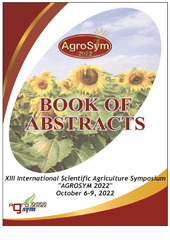Приказ основних података о документу
WEED INFESTATION OF WINTER WHEAT IN DIFFERENT TILLAGE SYSTEMS AND LEVEL OF NITROGEN IN TOP DRESSING
| dc.creator | Dolijanović, Željko | |
| dc.creator | Kovačević, Dušan | |
| dc.creator | Simić, Milena | |
| dc.creator | Oljača, Snežana | |
| dc.creator | Roljević Nikolić, Svetlana | |
| dc.creator | Šeremešić, Srđan | |
| dc.date.accessioned | 2023-12-15T12:22:48Z | |
| dc.date.available | 2023-12-15T12:22:48Z | |
| dc.date.issued | 2022 | |
| dc.identifier.isbn | 978-99976-987-2-8 | |
| dc.identifier.uri | http://aspace.agrif.bg.ac.rs/handle/123456789/6601 | |
| dc.description.abstract | Growing technology, especially tillage and fertilization of economically important crop species such as wheat, plays a very important role in weed control. Successful weed control in the crop in turn significantly affects the formation of grain yield, both in quantity and quality. The aim of this paper was to investigate the influence of sustainable (mulch - and no- tillage) and conventional farming system on weed infestation of winter wheat. Basic fertilization was uniform (600 kg/ha NPK 15:15:15) while weed infestation differences between three levels of nitrogen fertilization in top dressing (0, 60 and 120 kg/ha) were examined. The variety Pobeda, selected at the Institute of Field and Vegetable Crops in Novi Sad, served as the object of investigation. The examination was performed at "Radmilovac" on the experimental school property of the Faculty of Agriculture in Zemun within the four- crop rotation (maize-winter wheat-spring barley + red clover-red clover) on leached chernozem soil type in a two-year period. The system of conventional tillage showed the highest efficiency in the weed control (number of weed species and number of weed plants per species) of the two conservation systems. The next is the system of mulch tillage, which may be of interest for practice, while the system of no tillage had the lowest efficiency in the control of weeds, especially perennials. Increasing the amount of nitrogen in the top dressing reduces weeds in all tillage systems, mainly due to the stronger competitiveness of winter wheat. The highest fresh biomass of weeds was measured in the no-tillage system (especially in the second year of investigation) due to the significantly higher presence of perennial broadleaf weeds. | sr |
| dc.language.iso | en | sr |
| dc.publisher | University of East Sarajevo, Faculty of Agriculture, Republic of Srpska, Bosnia | sr |
| dc.publisher | University of Belgrade, Faculty of Agriculture, Serbia | sr |
| dc.publisher | ... | sr |
| dc.rights | openAccess | sr |
| dc.rights.uri | https://creativecommons.org/licenses/by/4.0/ | |
| dc.source | 13th International Scientific Agriculture Symposium „AGROSYM 2022” Jahorina mountain (Bosnia and Herzegovina), 6-9 October 2022. Book of Abstracts | sr |
| dc.subject | farming system | sr |
| dc.subject | fertilization | sr |
| dc.subject | nitrogen | sr |
| dc.subject | control of weeds | sr |
| dc.title | WEED INFESTATION OF WINTER WHEAT IN DIFFERENT TILLAGE SYSTEMS AND LEVEL OF NITROGEN IN TOP DRESSING | sr |
| dc.type | conferenceObject | sr |
| dc.rights.license | BY | sr |
| dc.citation.spage | 246 | |
| dc.identifier.fulltext | http://aspace.agrif.bg.ac.rs/bitstream/id/25159/bitstream_25159.pdf | |
| dc.identifier.rcub | https://hdl.handle.net/21.15107/rcub_agrospace_6601 | |
| dc.type.version | publishedVersion | sr |


